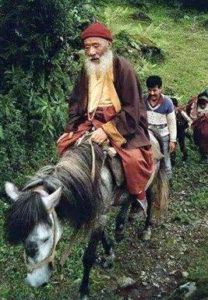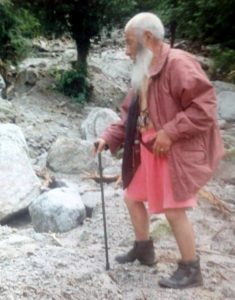Interview with Chatral Rinpoche’s daughter, Semo Saraswati
Dorje: Are you in this photo?
Semo la: No, I’m not there.
Q: I thought the person in the middle was you.
A: No, that is my sister, Tara Devi.
Q: Could you tell us who the people in this picture are?
A: From left to right: Meme Ngawang, Kathok Situ, the Prince of Sikkim, known as Denjong Gyalse, and other disciples like Buddha, Liece, Ongnyang, Woser Tulku, Sharibu, Tulku Pema, and Rahula. This photo was taken in Neding during the Jatsen Pedug (T. ‘Ja’ mtshon pod drug) initiation (T. dbang). On the right is Chatral Rinpoche, and on the other side, wearing glasses, is Dondrupchen Rinpoche.



Q: How long ago was this picture taken?
A: About 25 years ago.
Q: Dondrupchen Rinpoche doesn’t live in Nepal, does he? Does he live in India?
A: Yes, he lives in Gangtok, Sikkim. Chatral Rinpoche invited him to visit, and he stayed in Neding for about 15 days.
Q: Did Dondrupchen Rinpoche come by horse or helicopter?
A: By helicopter.
Q: You mentioned the Jatsen Pedug initiation, was it during that time?
A: Yes, it was during the Jatsen Pedug wang (initiation).
Q: Who gave the initiation? Chatral Rinpoche?
A: No, Dondrupchen Rinpoche gave the wang.
Q: Oh, then who received the initiation?
A: Everyone in the picture.
Q: Did Chatral Rinpoche receive the initiation at the same time as the others?
A: Chatral Rinpoche had already received it previously. There is a place called Gotsangling, where he didn’t give the full Jatsen Pedug wang but did give the Jatsen Tsasum (T. ‘Ja’ mtshon rtsa gsum).
Q: What was the reason behind inviting Dondrupchen Rinpoche?
A: He was invited because we follow the Longchen Nyingthig lineage, and Dondrupchen Rinpoche is a teacher of that lineage, so he was invited.
Q: As a layperson, I would think Chatral Rinpoche could have given the initiation himself. Why go through the trouble of inviting another lama?
A: Chatral Rinpoche did not often give wang or lung. Therefore, he invited Dondrupchen Rinpoche to give the initiation. Chatral Rinpoche preferred smaller gatherings and avoided large announcements. In Gotsangling, he gave the initiation to just a few lamas from Gotsangling and Tarkeghyang without making public announcements. We lived in Drupadong, very close to Gotsangling, and I was in retreat at the time. Chatral Rinpoche went to give the wang to about 10-15 lamas.
Q: You didn’t go?
A: No, I didn’t go; I was doing a three-year retreat at that time.
Q: You mentioned that Dondrupchen Rinpoche stayed in Neding for about 10-15 days. Chatral Rinpoche must have been very happy.
A: Yes, Chatral Rinpoche told us he was very happy. For Chatral Rinpoche’s request, Dondrupchen Rinpoche also gave the Nyingthig Tsasum wang at Chumig Changchub (T. Chu mig byang chub). When we were young, Dondrupchen Rinpoche was invited to give the Nyingthig wang in Yangleshö as well.
Q: From the photo, it seems there weren’t many people there.
A: That’s true, there weren’t many people.
Q: Did Chatral Rinpoche prefer not to give initiations to large groups of people?
A: No, he didn’t like that.
Q: There were many people who wanted to become disciples of Chatral Rinpoche. He must have given many teachings. What was the essence of his teachings?
A: These days, it’s common for lamas to give whatever teachings people ask for, but Chatral Rinpoche didn’t do that. People used to complain that he didn’t give enough teachings. He believed that whatever the guru does should be seen as the teaching of Guru Rinpoche. Even if the guru asks us to work, that is also part of the teaching. He made us stay in retreat, and that was his way of teaching. Many people didn’t understand and complained about not receiving teachings.
Q: What did he teach?
A: He taught from the book Kunsang Lame Shelung (T. Kun bzang la ma’i zhal lung, Words of My Perfect Teacher by Patrul Rinpoche, 1808–1887). Anyone who wants to practice the Dharma must study Kunsang Lame Shelung first. It contains all the necessary teachings for Dharma practitioners. If you understand it, that’s great, but if not, you need to work on mind training. Training should be done with the mind, not with the body, eyes, legs, or ears. You have to integrate the teachings with your mind and see if they resonate. Chatral Rinpoche could always tell if someone was genuinely practicing the Dharma or if they were just coming to receive teachings, leaving, and then using mantras to advertise themselves as a guru, going off to foreign lands. He didn’t like that. He wanted his disciples to go into retreat in a peaceful place and practice diligently, not to seek praise or attention.
Q: I have the feeling that he greatly benefitted those who went on retreat and practiced. What do you think about that?
A: He considered retreat to be a valuable practice. I never heard him say it explicitly, but one of the books says that even taking seven steps toward retreat brings good fortune. When you go into retreat, you engage in practices like ngondro (T. sngon ‘gro, “preliminary practices”), tsalung (T. rtsa rlung, “subtle energy practices”), phowa (T. pho ba, “mind transference”), and gom (T. sgom, “meditation”). But the most important thing is to integrate the Dharma into your mind. Showing Dharma externally is meaningless. He never gave strict instructions on what practices to do, where to go, or how long to stay in retreat. He believed that the changes happening in your mind were more important than external appearances.
Q: So, he valued inner transformation more than outward displays?
A: Exactly. When you practice Dharma, you should see change. If a person becomes worse, if their ego grows and they become proud, then it’s a sign that Dharma is not integrating with their mind. But if their devotion to the lama grows, if their compassion for all beings increases, and if they become more humble and friendly with everyone, those are signs of good Dharma practice. That is what integration with the Dharma looks like.
Q: Chatral Rinpoche had many disciples and was a guru for many teachings. As his daughter, do you plan to continue his teaching activities?
A: Yes, we do have plans. Just before the earthquake, Khenpo Ngawang Lendrup completed the construction of a retreat center in Neding, Hyolmo. Unfortunately, the earthquake destroyed it two months after completion, but Khenpo quickly rebuilt it. We follow the Nyingthig lineage, which is the lineage of Chatral Rinpoche. However, the Tamangs in the villages follow the Koncho Chindu lineage (T. dKon mchog spyi ‘dus) in all aspects of life, from birth to death. So, we also have people from Ramechhap, Sindhuli, and Kavre doing retreat in Neding according to the Koncho Chindu lineage. The retreat programs follow the tradition of Chatral Rinpoche. Similarly, in Godawari, a group completed a retreat in the 9th month of the lunar calendar, and we plan to start two retreat programs next 9th month: one in Nyingthig and one in Koncho Chindu. The centers didn’t stop after Chatral Rinpoche’s passing. We are working hard to continue his activities, and we will keep trying.
Q: It seems that Chatral Rinpoche placed special importance on Hyolmo as a place of practice. Why was that?
A: Because Hyolmo is a hidden land (T. sbas yul) concealed by Guru Rinpoche. When Chatral Rinpoche went to Hyolmo, he identified a new sacred place below Dufu (T. Yang dag mchog kyi sgrub phug), the Tongshongfug (T. sTong shong phug).
Q: Rinpoche spent many years in Hyolmo.
A: Yes, he lived there for many years. He traveled on foot to many places, including Bemthang, leaning on his walking stick, wearing half pants and rubber boots.



Q: After living in Hyolmo for so many years, do you know how he viewed the people of Hyolmo and their situation?
A: Things are going well there. Many Hyolmo people have moved to the USA for work, but they continue to practice Dharma while living there. Even with their busy lives, they always make time for prayers during tshechu (T. tshes bcu), engage in nyungne (T. smyung gnas), and establish tshokpas (T. tshogs pa, “associations” or “centers”). This is also because Rinpoche lived in Hyolmo, and the people there have deep devotion to him.
Q: Did he have any specific wishes for the people of Hyolmo?
A: His wish was for everyone to practice Dharma, not just in Hyolmo but everywhere. It wasn’t enough to practice Dharma in name only; he wanted people to engage with pure and meaningful Dharma. If his wish had been limited only to Hyolmo, it would have contradicted the concept of bodhicitta. We must have aspirations for the whole world. Rinpoche’s aspiration was that all people in the world practice Dharma, that all beings attain enlightenment through meditation, by doing ngondro, building stupas and statues, and through acts of liberation. This is all achievable.
Q: Is there any message you would like to convey at the end? Something you personally find important?
A: To everyone who may read or listen to this interview, I would like to say: simply saying “Kyabsuchi! Kyabsuchi!” to Rinpoche is not enough. We must practice what he taught us. Only then can we truly say we are his followers. Though his physical body is no longer with us, his blessings are always with us, and he can never be separated from us. We must follow his teachings. He told us to practice the Dharma, do ngondro, love everyone without distinction, learn to meditate, and then meditate. He taught us not to eat meat, not to kill animals, not to smoke, and not to drink alcohol. Even if we cannot accomplish great things, doing these simple things is already an excellent support for Rinpoche. These days, many people struggle to give up meat, but if you can, it would be a great offering to him.
Dorje: Thank you, Semo la, for your time.
Semo Saraswati: Ok, good.
